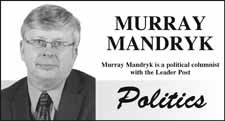So why don't we have a rainy day fund for real rainy days?
The most obvious answers is that we don't particularly want to pay more taxes and have been conditioned to believe any government surplus is just our tax dollars wasted.
Next to spending too much money - which created the deficits and debt in the 1980s for which we are still paying - the most egregious sin a government can commit is saving too much money.
But if you consider the way that the former Progressive Conservative government got into trouble, it was by deficit budgeting that also did not take into account the extraordinary economic circumstances created by the worst drought conditions since the 1930s.
As it turns out, flooding a quarter century later is as hard or harder on provincial coffers. And given that Saskatchewan in the last five years has endured the highest June precipitation amounts and worst flooding in a century, it's now as frequent.
By the time the sun finally peaked out last week, 53 Saskatchewan rural communities and small cities had declared a state of emergency, including the cities of Yorkton and Melville that had to evacuate its hospital. Some 800 people were forced to leave their homes.
The damage to these communities is in the hundreds of millions of dollars, although that may be matched by what east side farmers can expect to bear in crop loss.
Meanwhile, 19 Saskatchewan highways - including such major routes as the Trans-Canada, Yellowhead and Hwy. 10 to Yortkon - were all partially closed for days. Repair to these highways alone is expected to be in the tens of millions of dollars.
By all measure, our climate is changing. One need only look at what happened in Calgary last year or what has happened in places like Yorkton and Maple Creek in the last five years.
Whether this change in climate is all, partially or not at all be attributed to man may be less of an issue than the fact we seem to be facing wetter, more violent weather.
And we seem less ready for such disastrous weather events than we are 25 years ago when the problem was drought.
It was not great initial crisis management by the Saskatchewan Party government. It was either in long-weekend mode or it was not aware of the extent of the damage caused by the rains that started on a Saturday.
Highway hotlines were slow to react with warnings as politicians fumbled with a Provincial Disaster Assistance Plan that really has been updated since 2003. This, in itself, should tell us that more money must be set aside for better preparation for us for such events.
Admittedly, Premier Brad Wall and his cabinet did seem to rally on Canada by heading back to work on Canada Day to announce that damage would easily exceed the $360-million 2011 flood clean-up bill and that the province would dip into its $500-million rainy-day fund.
But despite this bravado, our problem with our "rainy day fund" is that can really be used for anything including balancing the books if revenue is underestimated.
We should have true contingency fund that can only be touched for the purposes of dealing with extreme weather events.
Sure, it may require sacrifices elsewhere in spending or maybe even resource or personal taxes to ensure that we can meet these more frequently occurring challenges.
But our wealth now has been created by our booming resource economy and the income it has generated. So why wouldn't we set aside a bit of that wealth each year and earmark it for weather disaster events as an insurance policy?
After all, most of attempt to keep a float in our bank accounts for those rainy days.
It's time government did the same thing.
Murray Mandryk has been covering provincial politics for over 22 years.




